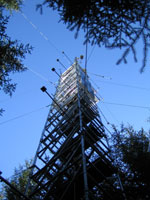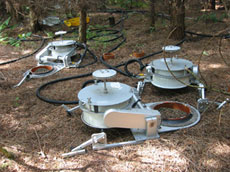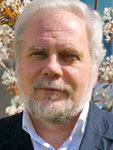The breathing forest
Posted on 1 October 2006

However, the forests of the world are receiving an increasingly bad press, with scientists beginning to question whether forests can be relied on to continue as our global allies. Some suspect that, under climate change, a large amount of the carbon which the forests have been storing for us will become vulnerable and released back to the atmosphere. Other scientists are becoming suspicious that although forests have been tucking away CO2 from the atmosphere, behind our backs they have been sneakily emitting other important greenhouse gases. So, where does that leave us - is the forest really a friend or foe in our fight against climate change?
Professor Phil Ineson and Dr Andreas Heinemeyer, from the Biology Department and Stockholm Environment Institute at York (SEIY), are studying the behaviour of the carbon cycle in forests with colleagues in the Centre for Terrestrial Carbon Dynamics. Their research is funded by the Natural Environment Research Council (NERC).
Breathing in
One major difficulty in answering how much CO2 a forest is gaining or losing is that forests both take up CO2 (through photosynthesis) as well as release it (through respiration); it is the balance which decides whether a forest is a net source or store of carbon. Scientists have had to come up with some very ingenious tricks to measure exactly how much CO2 a forest is breathing in and out.
To find out how much CO2 you produce in a day could involve sealing you in a room for a while and following the build-up of CO2. Obviously, we can't do this for a forest and the problem requires a very different approach. Instead, we draw an imaginary box around the forest and analyse every gust of air moving in and out of this box. The complex equipment used to do this needs to be placed on towers above the forest with measurements being taken dozens of times a second. In this way we can quantify whether a forest is taking up, or giving out, CO2 to the atmosphere.

Each forest which has been measured seems to have its own personality, with the forest having a very regular 'breathing' pattern, from year to year. By adding up all these values it is possible to work out how much carbon a forest is gaining or losing; critically, the balance seems to be controlled by the climate.
Breathing out
As forests get older they build-up a lot of carbon in wood and branches, as well as in rotting leaves and wood in the soil. Unlike the growing leaves, these parts of the forest can only release CO2 - they can't take it up. Again, scientists have been developing novel ways of measuring the breathing out from different parts of the forest. Somewhat surprisingly, one of the most important sources of CO2 in the forest is the respiration of the millions of organisms that have their homes in the soil.
The tiny insect (a springtail) is just one of the many microscopic organisms found living in decaying matter on the forest floor. Our concern is that, as the climate warms, organisms like this will become much more active, respire more and cause more CO2 to be released. We use the 'robotic' devices to measure this forest soil CO2 output, working day and night, across all seasons. With such equipment we can find out exactly how much CO2 comes out of forest soils and how this will change under climate change and the role in the future carbon cycle.
About the researchers

Phil Ineson is a Professor in the Department of Biology and the Stockholm Environment Institute at York
Contact
Email: pi2@york.ac.uk

Dr Andreas Heinemeyer is a Senior Research Assistant in the Stockholm Environment Institute at York
Contact
Email: ah126@york.ac.uk
Further information
- http://ctcd.group.shef.ac.uk/ctcd.html
The NERC Centre for Terrestrial Carbon Dynamics - www.nerc.ac.uk
NERC's wider programme of climate related research - www.geos.ed.ac.uk/abs
Forest C budget methods - Stockholm Environment Institute at York
